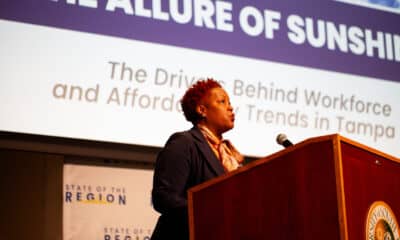Thrive
‘These trends are not new:’ racial equity issues continue to impact Tampa Bay as leaders search for solutions

The Tampa Bay Partnership recently released its 2020 Regional Equity Report, revealing the dramatic inequities that exist for Black residents both within Tampa Bay and in comparison to 19 other cities across the U.S.
On Thursday, panelists at the virtual State of the Region Community Forum took a closer look at these inequities, why they exist and what can be done to change them in an attempt to create an economy and a society that works for everyone.
“These trends are not new,” said Braulio Colón, vice president of Florida Student Success Initiatives for the Helios Education Foundation. “These gaps have existed for decades. We should not let this report sit on the shelf – it can be a tool for helping our region move forward.”
An analysis of 21 indicators related to economic vitality, talent, infrastructure, civic quality, poverty and employment showed that Tampa Bay’s Black residents are far more likely to be paid less, live in poverty and attend underperforming schools compared to the region’s white residents. Without intervention, these disparities – and others – are likely to become more pronounced as a result of the pandemic.
Related content: Tampa Bay Partnership CEO: New report is a reality check on racial equity
Much of Thursday’s discussion centered around the topic of systemic racism, which the panelists agreed is embedded in all aspects of society.
“Growing up here, I constantly saw it,” said Yvette Lewis, president of the Hillsborough County Branch of the NAACP. “The powers that be never ask you anything – they tell you what you’re supposed to do. Systemic racism is rampant, it constantly suppresses African American people and it has to be recognized by the business community and our elected officials.”
Bemetra Simmons, chief strategy and operations officer at United Way Suncoast, said that systemic racism has permeated everything from education to health care to the criminal justice system.
“It shows up everywhere, and it’s ongoing,” she said. “It’s not a past-tense thing.”
One of the most significant findings from the report was the 32 percent gap in home ownership between Blacks and whites.
“Where you live drives so much – the schools you attend, the grocery stores that are available, what public transportation is available,” she said, adding that the gap in credit scores and the income disparities between Blacks and whites contribute to low rates of home ownership for African Americans. “It’s not getting better.”
Lewis remembers growing up in local neighborhoods with longevity, where everyone knew and looked out for one another. Now, those areas are harder to find.
“Most of the homes are owned by white landlords who couldn’t care less about the neighborhood. They’ll rent to anyone to get money and they don’t try to fix it up,” she said. “It depletes our neighborhood.”
Panelists also discussed the disparities in education, which Colón said can be mitigated with the expansion of early learning opportunities and quality VPK programs. He said that local leaders need to look beyond graduation rates when seeking solutions to educational inequities.
In addition to education, inequities in health care continue to impact the Black community, especially in light of Covid-19. This is another instance where systemic racism comes in by discouraging people who want to better themselves by finding jobs, by penalizing and taking away their Medicaid benefits, Lewis said.
“You end up stuck in a system that the government oppresses upon us,” she said. “You’re stuck in the middle of a hole – now what do you do?”
Simmons added that it’s not just the cost of healthcare that contributes to inequities, it’s how people of color are treated when they seek medical attention.
“Black women are dying in childbirth. The Black kid who goes to the ER will wait longer than a white kid,” she said, noting that the healthcare system needs more practitioners of color. “It’s not just the cost. It’s the whole umbrella of how Black and Brown people are treated in the healthcare system.”
As the discussion wrapped up, panelists grappled with the question of “where do we go from here?”
Simmons and Lewis pointed to the need for businesses to promote diversity and create pathways for minorities to move into leadership roles. That may mean taking a chance on “someone who doesn’t look like us,” Simmons said, and giving that person the tools they need for professional development.
“If you’re sitting in a boardroom and everyone looks like you, there’s something wrong with your company,” Lewis agreed. “My challenge to every leader is that they must ensure that everyone is treated equally and given the opportunity to grow.”
Colón said he’s hopeful that the report will help the Tampa Bay area create targeted action plans to improve the quality of life for minority residents. He believes the region is up for the task.
“This is our challenge to overcome and we can do it,” he said. “We need to continue the conversation and design a road map to help get us to where we want to be.”








Carl Lavender
September 3, 2020at4:34 pm
Excellent work on behalf of the Partnership. I was on the call. Stay tuned. Major changes forthcoming.